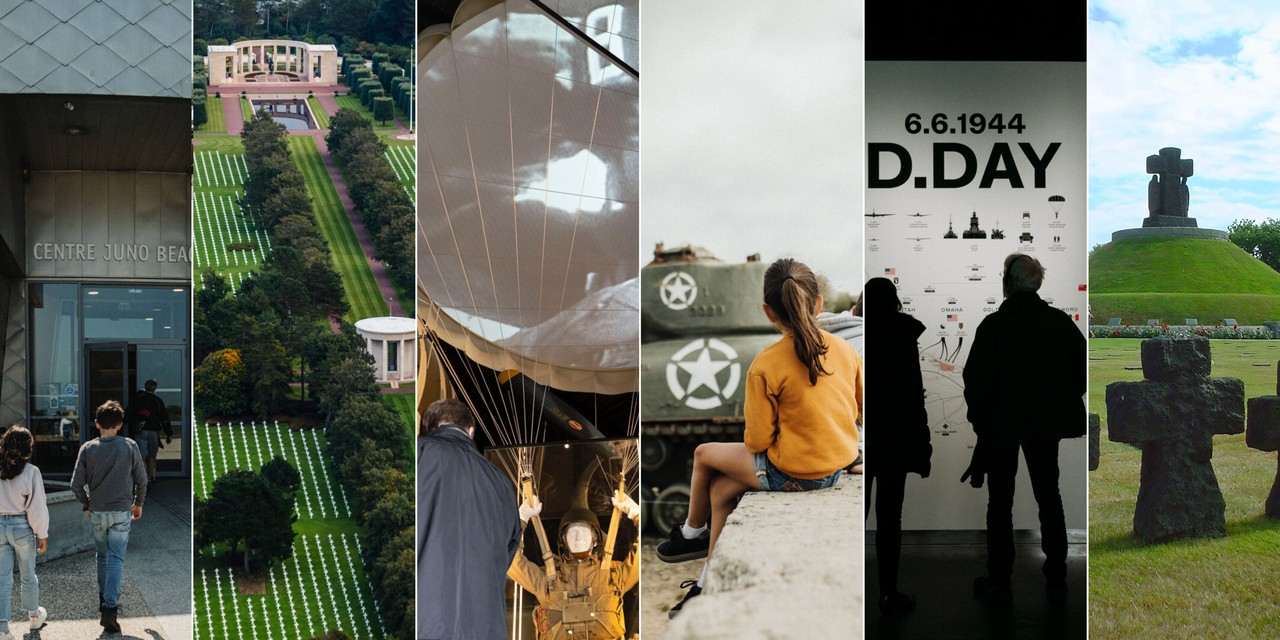Normandy holds a unique place in history as the starting point of Europe's liberation. On June 6, 1944, the Allies launched the largest seaborne invasion in history, landing on five Normandian beaches. While these beaches attract tourists for their beauty and historical importance, Normandy offers much more than just this. Today, with the 80th anniversary of the landing approaching, we're highlighting six unique places that delve deeper into these events, offering opportunities for reflection and a deeper understanding of the process of the liberation of Europe.
Juno beach centre
The Juno Beach Centre, established in 2003 in Courseulles-sur-Mer, is more than just a D-Day museum—it's a national memorial representing Canada's significant role in WWII. Canada, alongside the UK since 1939, mobilized its resources, becoming a vital part of the war effort and earning the title of the 'arsenal of democracy'. Despite tensions over conscription, Canada sent over a million volunteers to fight, maintaining national unity. The Centre showcases Canada's contributions through thematic exhibitions and a poignant film, 'Dans leurs pas' ('They walk with you'), allowing visitors to connect with individual soldiers' experiences.
Normandy American Cemetary
The American Military Cemetery in Colleville-sur-Mer stands as a tribute to the 9387 American soldiers who perished during the Battle of Normandy. Situated overlooking Omaha Beach, where their sacrifices were greatest, its rows of white marble crosses and Stars of David evoke the Allied nations' commitment to freedom. The cemetery features striking elements like columns, statuary, and a reflective pond. The semi-circular wall commemorates 1557 soldiers still missing in action. Interactive displays detail Allied operations, while a vantage point offers sweeping views of Omaha Beach. Since 2007, a visitor center provides insight into the battles' course. Notable for its significance, it's a customary stop for American presidents and a testament to enduring transatlantic ties.
Airborne museum
The Sainte-Mère-Église Museum, established in 1964, stands as a key landmark in the Normandy landings area. Immortalized in film, notably 'The Longest Day,' it honors American paratroopers of the 82nd and 101st Airborne Divisions who landed on the Cotentin Peninsula on June 5-6, 1944. Showcasing weaponry and artifacts, including the iconic Douglas C-47 and rare Waco glider, the museum offers an immersive experience. Veterans' personal contributions enrich its exhibits with poignant narratives. An extension, inaugurated in June 2014, delves deeper into the paratroopers' post-landing battles, featuring modern displays that trace the emotional journey of these brave soldiers.
D-Day Museum Utah Beach
The Utah Beach Landings Museum, opened in 1962 and renovated in 2011, stands on the former German strongpoint conquered by the U.S. on D-Day. It highlights the 4th U.S. Infantry Division and 8th Infantry Regiment, first to land. Exhibits depict the historic landing moments, focusing on the U.S. Corps of Engineers' crucial role in clearing obstacles. The museum showcases war items and logistics of the beach landings, including the significant presence of the 101st U.S. Airborne Division. A rare Martin B26 G ‘Marauder’ bomber, a central exhibit, commemorates Allied Air Forces' contributions during and after the Utah Beach landing.
The German Cemetery in La Cambe
La Cambe German Military Cemetery, also situated near the Omaha Beach commemorates the 21,245 German soldiers who rest there, marked by symbolic crosses instead of individual names. Architect Robert Tischler's design emphasizes silence and reverence, with a narrow entrance leading to communal graves and a burial mound. An exhibition in the information center reflects on war's toll, juxtaposing stories of suffering with hopeful examples of reconciliation. La Cambe's history includes an international youth camp for reconciliation and the establishment of Peace Park nearby. With barrier-free access completed in 2012, the site is easily reachable, ensuring all visitors can pay their respects safely.
D-Day Museum Arromanches
The Landing Museum (D-Day Museum) in Arromanches is a perfect choice for anyone interested in history and engineering. The museum offers an in depth insight into the construction of the artificial port of Arromanches in Britain. Through exhibits, including a model and film, visitors can learn about the port's creation and usage. Funded by the sale of wrecks from the surrounding coastal area, the museum opened on June 5, 1954, making it the first to narrate the events of June 6, 1944, and beyond in Normandy. Positioned in front of the former port, the museum details the deployment of floating breakwaters and the construction of piers and concrete caissons. Floating docks and causeways, depicted in the museum's model, showcased the port's dynamic functionality. Despite the challenges, the exhibition highlights the port's resilience, including surviving a fierce storm in June. Visitors can explore the beach to view remnants of the artificial harbor's floating road, providing a tangible link to this remarkable engineering achievement.
These six unique places offer diverse perspectives on the history of the Normandy Landing. Whether it's engaging interactive activities for children on Juno Beach or the solemn tranquility of a silent walk through the German Cemetery in La Cambe, each location provides a perfect opportunity to learn and reflect on our past and present.
Interested in learning more about the historical places related to WW2? Check out Europe Remembers for more information about museums, destinations and trips, or follow us on Facebook, Instagram or Twitter.
Europe Remembers is a campaign of the LRE Foundation to commemorate and celebrate 80 years of freedom in 2023-2025.
